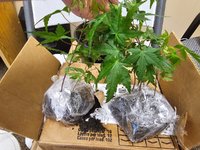DMagnum10
Seedling
Hi everyone,
I'm sure I'm probably just overthinking this, but in years past I've had unfortunate luck keeping seedlings and younger plants alive. Today, i received these Arakawa seedlings by mail. They were advertised in small pots, but arrived bagged in soil per the pictures. Given that the roots are so unstable in this state, I'm guessing the best course of action would be to repot into individual pots before setting them in the shade to acclimate.
Would it be better to try to slip the whole soil mass into a pot in an attempt to disrupt the roots as little as possible, then repot individually in early spring?
Also, my apologies if this has been covered recently. Upon searching, I didn't see any other posts dealing with anything quite like this.
I'm sure I'm probably just overthinking this, but in years past I've had unfortunate luck keeping seedlings and younger plants alive. Today, i received these Arakawa seedlings by mail. They were advertised in small pots, but arrived bagged in soil per the pictures. Given that the roots are so unstable in this state, I'm guessing the best course of action would be to repot into individual pots before setting them in the shade to acclimate.
Would it be better to try to slip the whole soil mass into a pot in an attempt to disrupt the roots as little as possible, then repot individually in early spring?
Also, my apologies if this has been covered recently. Upon searching, I didn't see any other posts dealing with anything quite like this.


